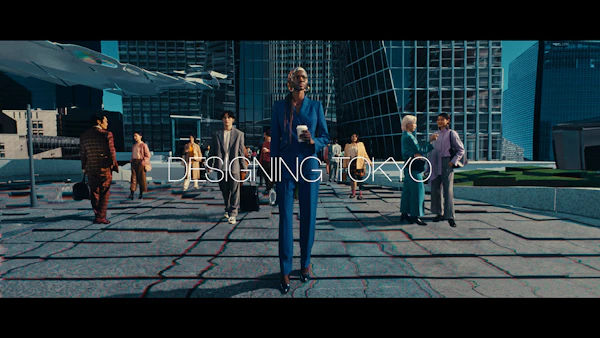Resource-recycling Cities (Pollution and Resources, Water, etc.)
資源循環型の都市(汚染と資源、水など)
Recognition and Policy on Pollution and Resources
Recognition
Economic and social activities based on mass production / mass consumption are closely related to various environmental issues such as climate change problems, depletion of natural resources, and loss of biodiversity. Mori Building recognizes that because of the large number of human activities in urban areas, it is necessary to promptly promote the transition to a circular economy that uses resources in a sustainable manner by taking countermeasures against pollution.
Policy
Mori Building strives to reduce, reuse, and recycle waste through the efficient use of resources in collaboration with various stakeholders by taking appropriate pollution control measures in daily operations, starting from the construction phase of the city. It also promotes the transition to a circular economy that uses resources in a sustainable manner through the creation of mechanisms and services to facilitate these efforts, aiming to create a resource-recycling city.
Pollution
Mori Building prevents environmental pollution by complying with all laws, regulations, and ordinances related to air pollution, water pollution, soil contamination, and other harmful substances. It will also comply with the standards set forth in any environmental certifications it obtains for its buildings.
Resources
Mori Building devises ways to reduce the amount of waste generated and strives to improve the recycling rate by promoting sorting and recycling. In addition, in accordance with the Plastic Resource Circulation Act, it will set targets for the reduction and recycling of industrial waste from plastic products, and will systematically implement initiatives to achieve these targets.
Targets and Progress on Pollution
In development, at the time of land acquisition and from the building design phase through the construction and operation phases, Mori Building properly manages and disposes of hazardous substances to prevent them from affecting the environment and the health of building users.
With regard to potential soil contamination in development areas, the company conducts soil investigations in accordance with laws and ordinances and, when necessary, implements appropriate treatment, including decontamination. For nitrogen oxides (NOx) and sulfur oxides (SOx), which cause air pollution, it operates boilers and combustion equipment in accordance with regulations and standards. The company also complies with air and water quality standards in the buildings by conducting periodic measurements in accordance with laws, regulations, and ordinances. In addition, as of 2018, it had substantially completed the treatment of polychlorinated biphenyls (PCBs), which are hazardous wastes, in accordance with the Act on Special Measures Concerning the Promotion of Proper Treatment of PCB Wastes. As for asbestos, it is also taking appropriate measures in compliance with the latest laws and regulations.
Targets and Progress on Resources
Mori Building aims to achieve a waste recycling rate of 75% by 2030 for the office buildings it manages and operates. In new projects, it aims to further improve the rate by weighing and visualizing each tenant's waste by day and by item to ensure thorough sorting and subdividing.
For plastics, it has set the following plastic reduction targets based on the "Plastic Resource Circulation Act".
Targets for Office Buildings
- Reduction of waste emissions: By 2030, reduce the amount of plastic and other waste generated from office buildings per square meter of floor space compared to the previous year
- Promotion of waste recycling: 100% recycling of plastic and other waste (including heat recovery)
Targets for Interior Construction
- Targets are being established for reducing waste discharge and promoting recycling, etc.
In buildings managed and operated by Mori Building, tenants and facility users work together to reduce waste by promoting Reduce, Reuse, and Recycle (3Rs). In office buildings in particular, 3Rs activities are progressing thanks to the understanding and cooperation of tenants, and the recycling rate is improving as trash is properly sorted at the time of disposal. In FY2021, the waste recycling rate was approximately 53%, and the plastic waste recycling rate, including heat recovery, was 100%.
Major Initiatives Concerning Pollution and Resources
Prevention of Soil Contamination
In accordance with relevant laws and regulations, Mori Building conducts proper geo-historical investigations on redevelopment sites. Soil contamination investigations and remediation measures are also conducted as necessary.
Handling of Asbestos
During demolition/renovation construction, Mori Building takes appropriate measures in accordance with the latest asbestos-related laws and regulations. In cases where asbestos is contained in the fireproof cladding material of existing buildings, it is removed or partially blocked when tenants are replaced.
Initiatives to Reduce Plastic Emissions
Initiatives in Office Buildings
- Distribution of recycling handbooks to tenants in-person and use of sorting stickers to ensure separation of waste before disposal
- Detailed weighing by tenant and by item in some buildings
- In the service agreement with waste disposal vendors, it is stipulated that "Priority will be given to material recycling and chemical recycling of wastes, and only the portion that cannot be treated will be subjected to heat recovery."
Initiatives in Contracted Construction
- Monitoring the amount of plastic waste
- Replacement of wall curing material with cardboard, reuse of blue veneer as floor curing material, and consideration of alternative materials
- Improvement of material recycling rate
Mori Building's Single-use Plastics Reduction Challenge
Mori Building has launched a company-wide project, "Mori Building's Single-use Plastics Reduction Challenge", to reduce single-use plastics (disposable plastics) in its offices and directly managed service businesses (residences, hotels, museums, etc.) with the goal of eliminating single-use plastics by 2030. This project identifies single-use plastics currently used by Mori Building and promotes a company-wide effort to reduce single-use plastics through a four-step process: raising employee awareness, eliminating unnecessary plastics, shifting to alternatives, and creating new mechanisms. Efforts have already been made to replace toiletries used in residences, to change the materials of plastic straws and cutlery, as well as discontinue the use of plastic bottles for serving tea in the conference rooms at the head office.
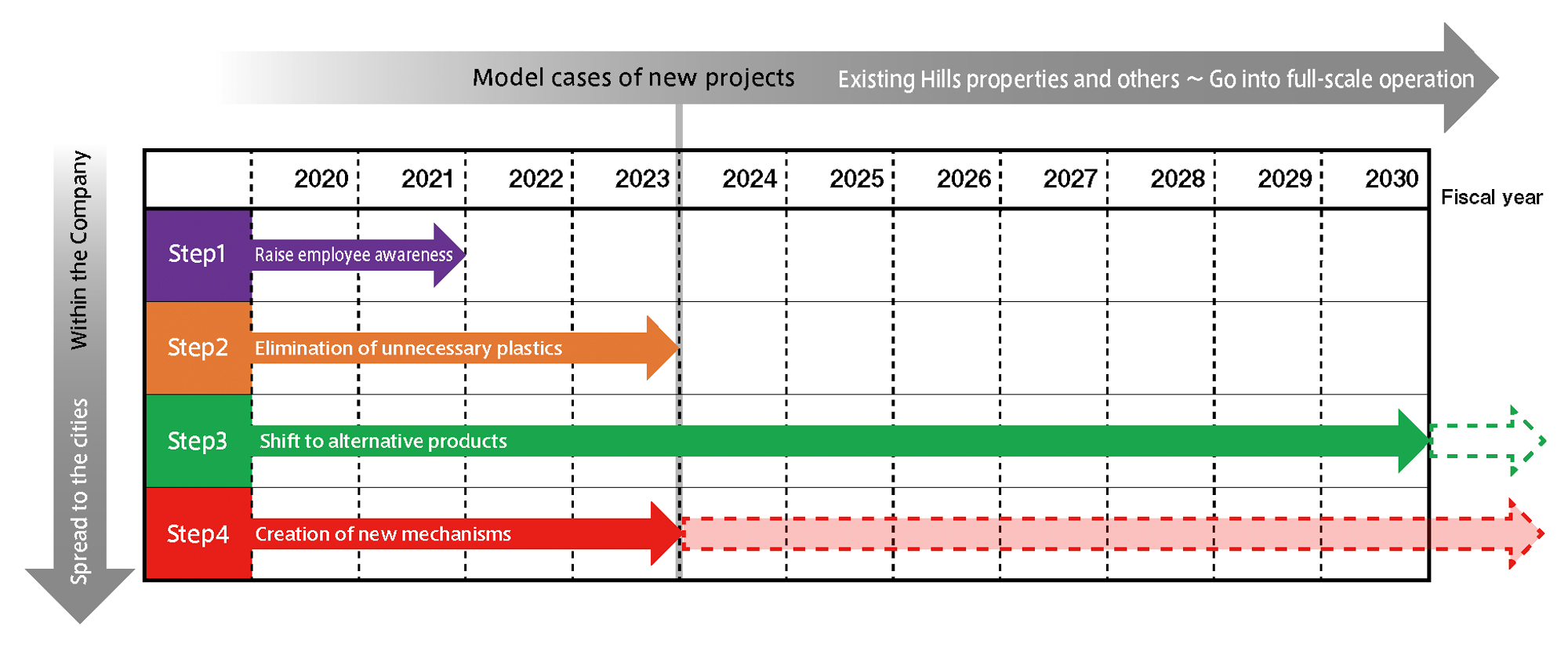
Progress Schedule of the Mori Building Single-use Plastics Reduction Challenge
3Rs Activities in Office Buildings
Proper sorting of trash at the point of discharge is very important for business facilities, where it is difficult to ensure thorough recycling. Office buildings managed by Mori Building are promoting 3Rs activities with the understanding and cooperation of tenants in order to improve the recycling rate.
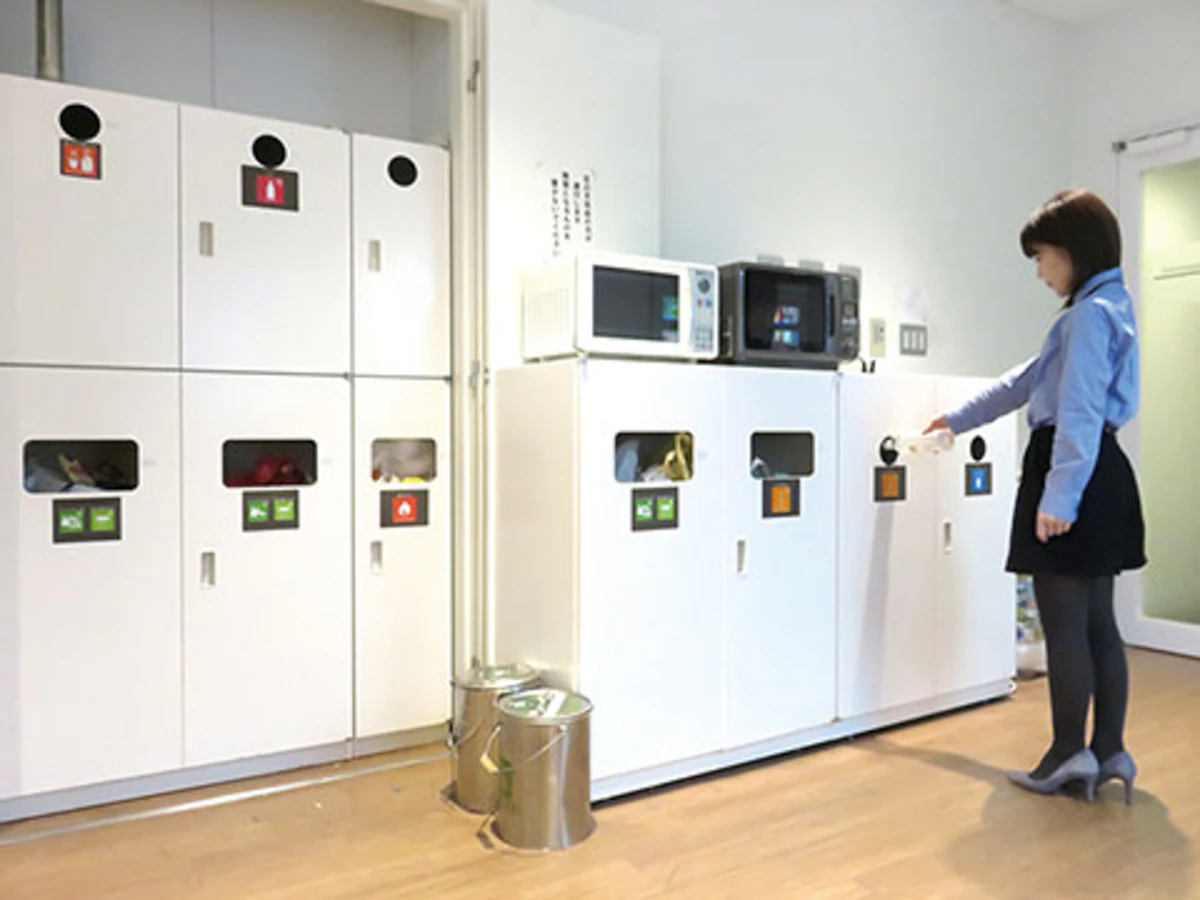
Promotion of Recycling in Offices
Mori Building promotes recycling by establishing its own rules for sorting trash into 16 categories and providing trash cans for each category. It weighs the sorted trash, summarizes the quantity and recycling rate for each building, and reports the results to its tenants. The processing rate, including heat recovery, of recycled paper and plastics is 100%.
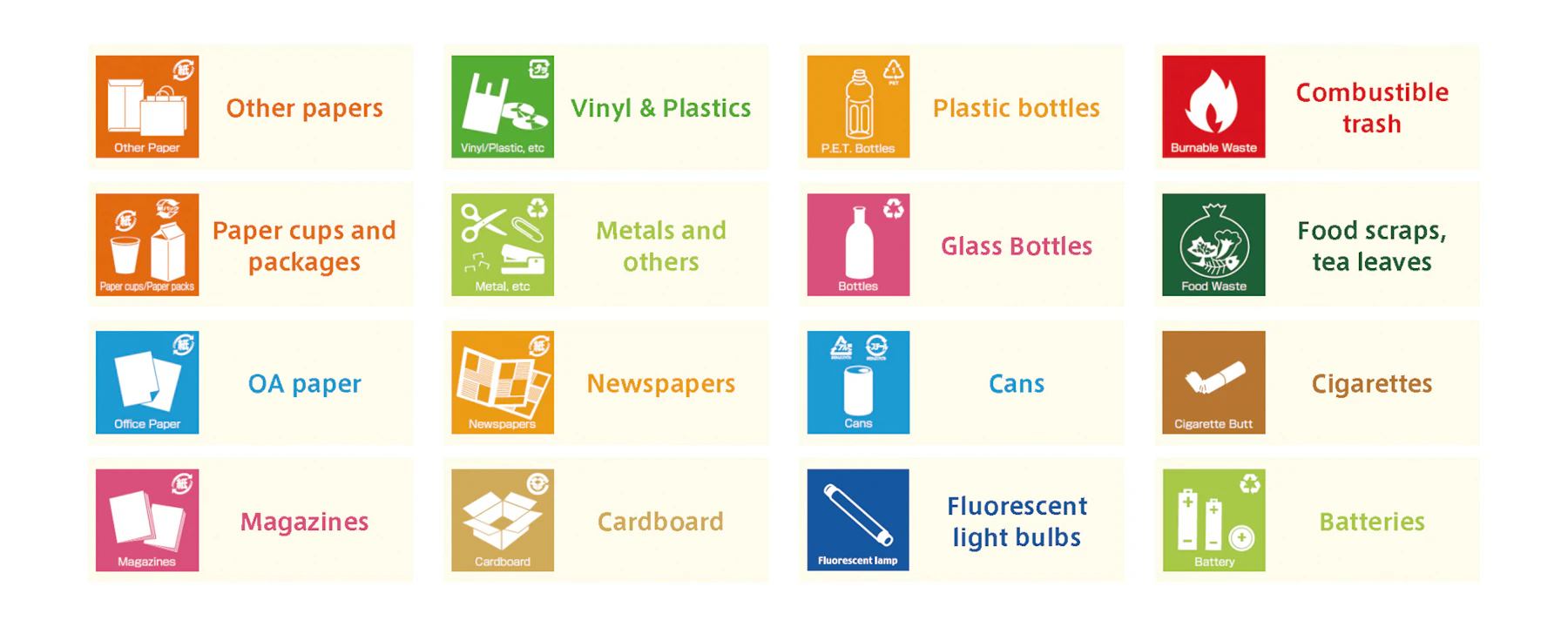
16 categories of trash in offices
Promoting Dialogue with Tenants on Resource Recycling
Mori Building produces and distributes a "RECYCLING HANDBOOK" for tenants to deepen their understanding of resource recycling and trash sorting.
Introduction of the Waste Management System
In FY2015, Mori Building introduced a waste management system. Data on the quantity of waste weighed at buildings managed and operated by Mori Building is entered into the system, and the quantity of waste by building and by type of waste is managed centrally in a timely manner. This allows Mori Building to respond quickly to changes in the law, and quickly and flexibly improve daily operations.
In addition, for new properties such as the Azabudai Hills and Toranomon Hills Station Tower, waste quantity data by tenant, by day, and by item is visualized on the Web for tenants, assisting them in further reducing waste and promoting waste sorting.
3Rs Activities in Construction
Initiatives in Building Construction
Mori Building is working with construction companies to eliminate waste materials and debris at construction sites. For new construction projects, we check Waste Control Plans and Waste Control Reports to reduce and recycle waste.
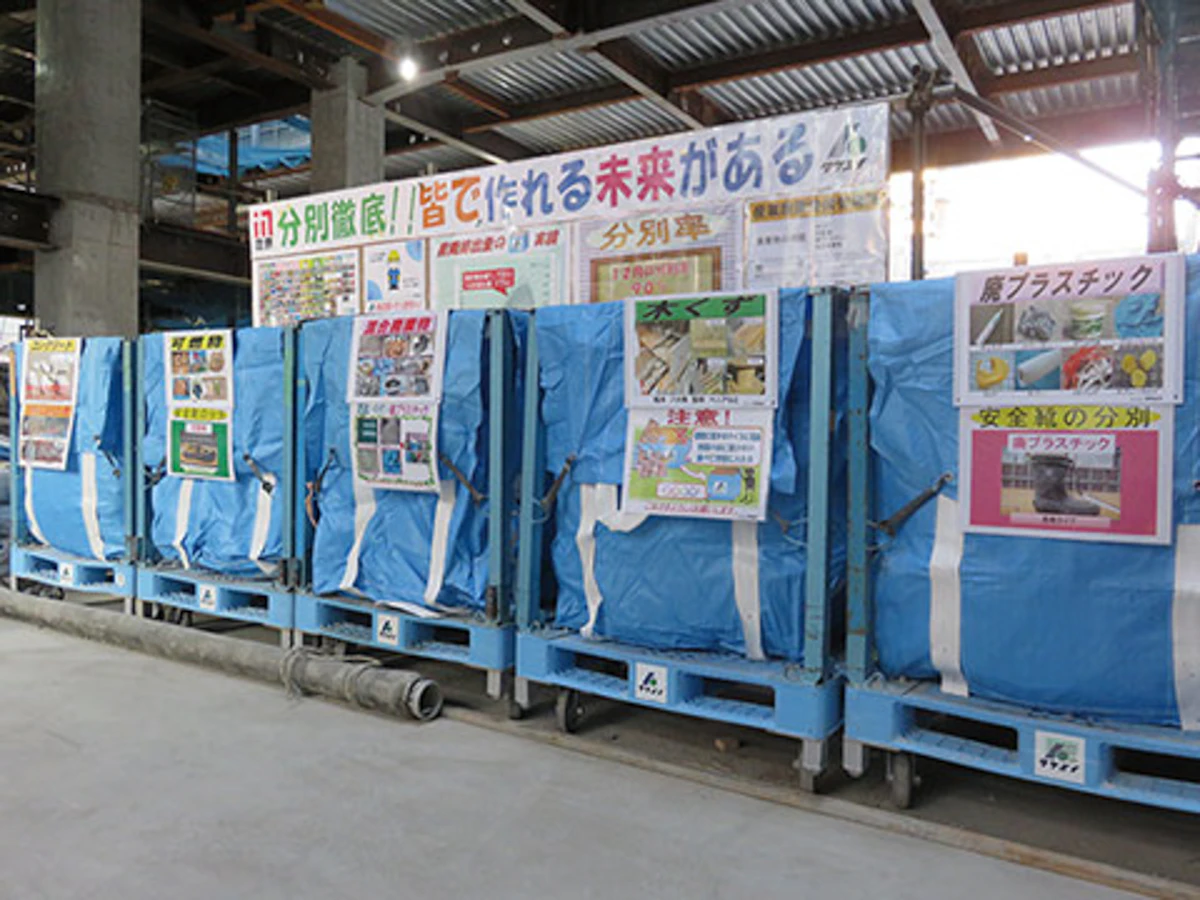
Initiatives for Interior Construction
Mori Building has installed waste cage trolleys by item during office interior construction to ensure thorough sorting of trash and improve the recycling rate. When discharging the waste, each waste cage trolley is loaded onto the back of a waste collection vehicle. As a result, the time required for waste accumulation and the waiting time for waste collection vehicles are reduced, and the elimination of transshipment work has also improved the work environment by controlling dust. In addition, the operating time of heavy equipment at the intermediate waste treatment facility has been reduced, which is expected to improve the recycling rate and reduce CO2 emissions.
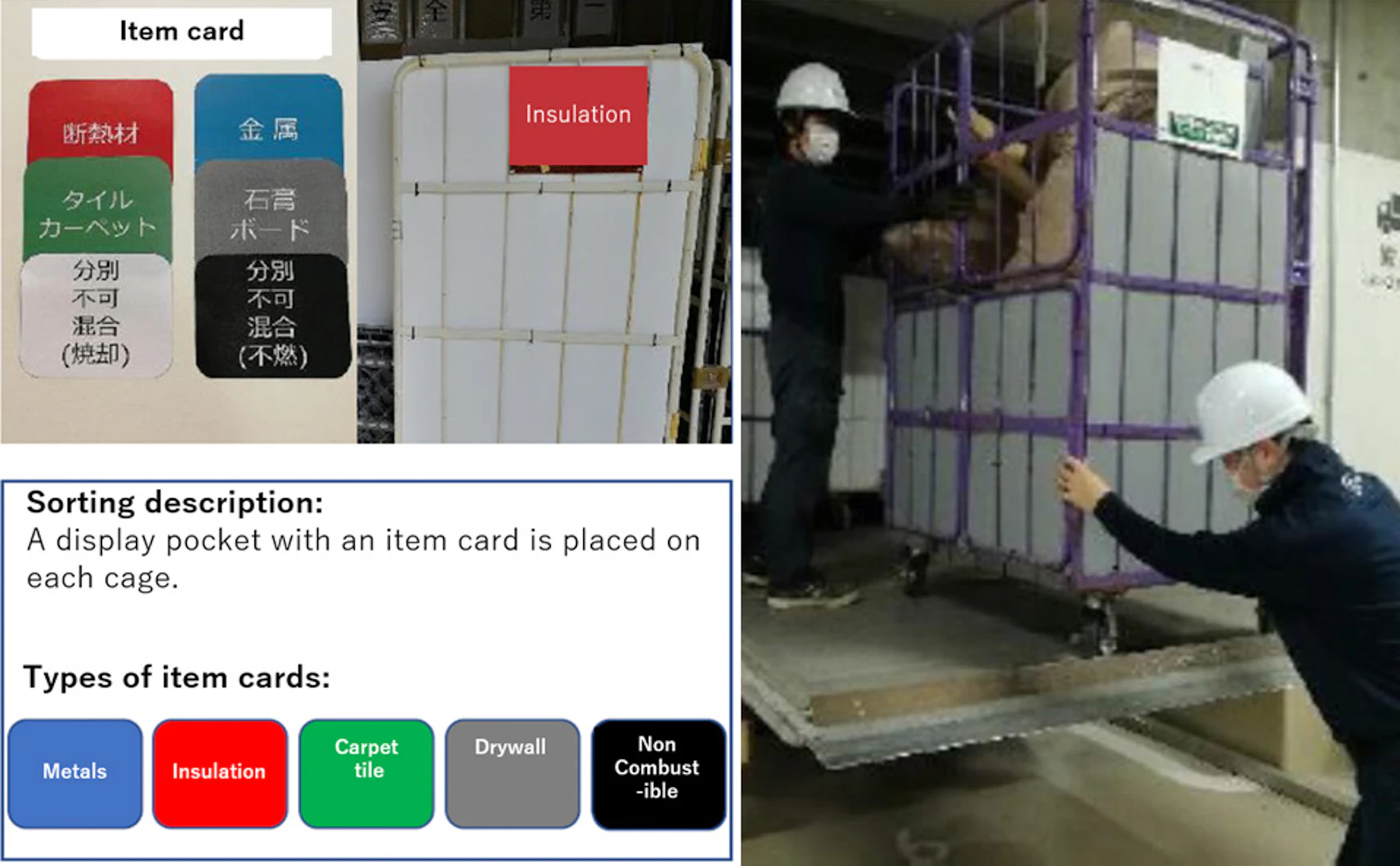
Thorough Recycling and Reuse of Carpet tiles
Since 2009, Mori Building has implemented a recycling system for used carpet tiles generated from offices managed and operated by Mori Building, as well as a standardized use of Eco Mark certified carpet tiles. In the future, as the first project with partner manufacturers, it will promote horizontal recycling by starting a system to recycle carpets including the pile layer into new carpets. In addition, Mori Building will work with manufacturers to create a system for reusing unused carpets that were previously disposed of in order to reduce waste even further.
Initiatives at Omotesando Hills
At the Omotesando Hills commercial complex, Mori Building is working together with its tenants to improve the waste recycling rates. The Omotesando Hills complex has achieved a 100% food waste recycling rate, thanks to thorough waste sorting. By attaching stickers with the names of tenants to trash bags for food waste generated by tenants, the initiative of tenants to sort trash and the accuracy of trash sorting have been improved. In addition, unannounced checks are conducted periodically to check the status of trash sorting, and guidance is provided to tenants.

A trash bag with a sticker of tenant' name
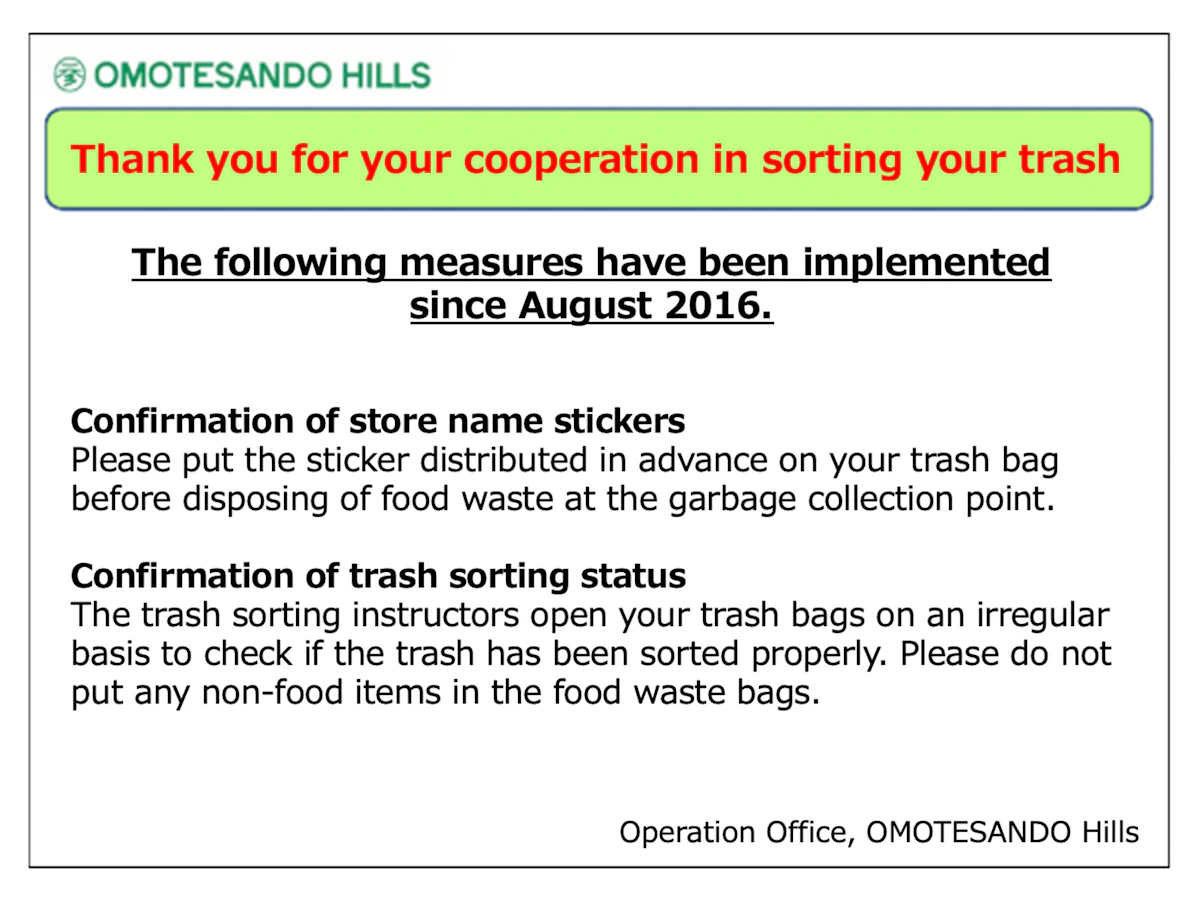
Request for cooperation from tenants
Collaboration with Other Companies on Pollution and Resources
PET plastic bottle "Bottle to Bottle" Recycling Demonstration Experiment (November 2021 - February 2022)
In order to begin studying the establishment and operation of a new system for recycling PET plastic bottles into beverage containers through cooperation among waste generators, beverage manufacturers, and recyclers, Mori Building collaborated with Roppongi Hills' partner companies, Coca-Cola Bottlers Japan Inc., Coca-Cola(Japan)Company, Limited, and Tomra Japan Ltd. The bottles were collected using special automatic collection machines and existing sorting collection bins at the demonstration area in Roppongi Hills Mori Tower.
It was conducted as part of the "Advanced Model Project on Recycling of Plastic Resources of the Ministry of the Environment" under a Program "FY2021 Research and Study Commission toward the Promotion of the Use of Bioplastics and Recycled Materials" by the Ministry of the Environment.
PET plastic bottle Recycling Demonstration Experiment Flow
Reuse of Bento Containers - LOOP Demonstration Experiment "Loop Takeout Bento" (December 2020 - February 2021)
This is an initiative to create a platform to reduce food plastic by selling bento in lunchboxes made of durable recycled materials and promoting the collection, cleaning, and reuse of containers. Mori Building collaborated with LOOP JAPAN LLC, the leader of this initiative, to conduct a demonstration experiment targeting Mori Building employees. Specifically, employees purchase bento lunches in special lunch boxes made of recycled materials at a café in Roppongi Hills, and return the used containers to the café after eating. The used containers are collected by a management company and transported using surplus SAGAWA EXPRESS CO., LTD. trucks to a washing center, where the containers are cleaned and sanitized before being used again at restaurants. The operation was attempted in this way and challenges were identified for implementation.
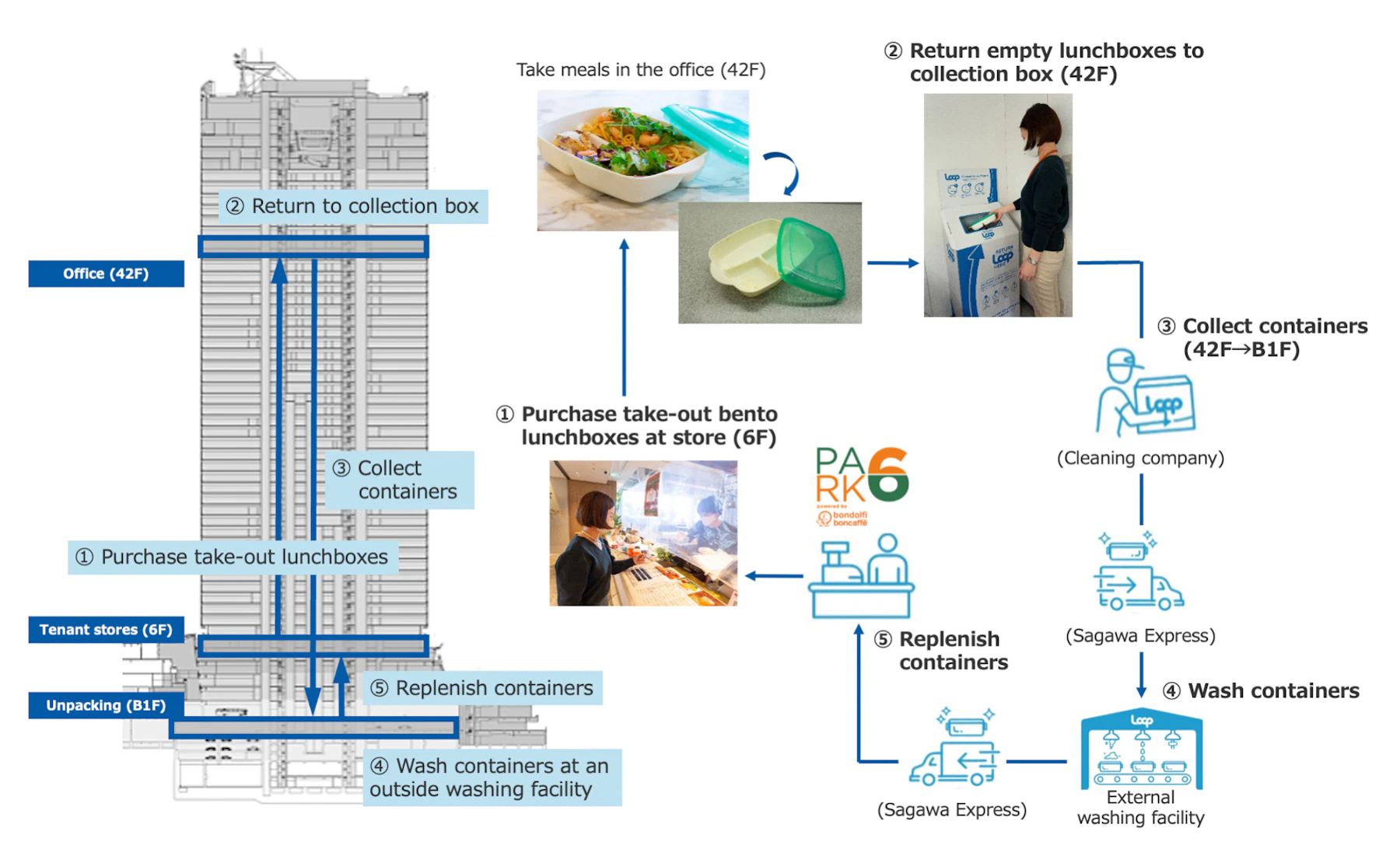
Demonstration experiment flow of recycling reused bento lunch boxes
KPIs and Performance Data on Pollution and Resources
Pollution-Related Data
Amount of Pollutant Emissions
Under compilation
Number of Violations Related to Pollution or Resources
In FY2021, the Mori Building group had 0 cases of violations related to air pollution, water pollution, soil contamination, other hazardous substances, waste, and other environmental pollution, and the annual cost of fines and penalties was also 0 yen.
| FY2019 | FY2020 | FY2021 |
|---|---|---|---|
Number of violations | 0 | 0 | 0 |
Waste-Related Data
| FY2019 | FY2020 | FY2021 | |
|---|---|---|---|---|
Total floor area (m²) | 1,403,641 | 1,559,728 | 1,531,278 | |
Number of subject property buildings | 36 | 34 | 23 | |
Japan | Large-scale complexes | 2 | 2 | 3 |
Offices | 34 | 32 | 20 | |
- Data covers office buildings managed by Mori Building
- Excluding properties managed by the Mori Building group companies
- Excluding properties for retail, residential, and other uses
Indicators | Unit | Target (KPI) | FY2019 | FY2020 | FY2021 |
|---|---|---|---|---|---|
Volume of waste per m² | Kg/m² | Reduced from previous FY | 5.28 | 3.05 | 3.16 |
Total waste | Tons | ― | 7,419 | 4,765 | 4,840 |
Waste recycle rate | % | 75% | 50.2% | 53.9% | 52.5% |
Volume of waste recycled | Tons | ― | 3,724 | 2,570 | 2,545 |
Volume of non-recycled waste | Tons | ― | 3,695 | 2,195 | 2,295 |
Indicators | Unit | FY2019 | FY2020 | FY2021 |
|---|---|---|---|---|
Volume of plastic waste | Tons | 778 | 532 | 557 |
Recycle rate (including heat recovery) | % | 100 | 100 | 100 |
Volume of Plastic Waste and Waste Reused in Contracted Construction
Under compilation
Recognition and Policy on Water Resources
Recognition
Water resources are essential for the survival of living things, including humans. However, the amount of available freshwater is limited, and water shortages are becoming increasingly serious due to water demand pressures and water pollution against a backdrop of global population growth and economic development. Mori Building recognizes that the effective use of water resources in urban areas with high demand for water is a particularly important issue.
Policies
Mori Building will adopt sanitary fixtures with high water-saving performance in new buildings and actively introduce systems that use rainwater and recycled water. It will also adopt the latest water-saving fixtures when renovating plumbing products in existing buildings, and will promote water conservation and water recycling to the fullest extent possible through building management and operations.
Targets and Progress on Water Resources
Water Resource Targets: In order to achieve a reduction in water consumption per unit of production compared to the previous year, Mori Building strives to conserve water and maximize the effective use of water resources through daily management and operations.
Major Initiatives Concerning Water Resources
Adoption of Water-saving Fixtures
Mori Building strives to save water by promoting the installation of water-saving fixtures in new buildings and their replacement at the time of renovation. In its newest developments, water-saving devices with high performance have been installed in automatic combination faucets, toilets, showers, and other fixtures.
Utilization of Rainwater and Recycled Water
Mori Building is committed to utilizing rainwater and recycled water in its developments. This initiative also serves to reduce rainwater runoff, and Mori Building collects rainwater from the entire site, stores it in rainwater tanks, filters it, and reuses it mainly for sprinkling water on exterior plantings. At a large-scale complex, wastewater that is relatively clean, such as that used for hand washing, is treated by filtration and disinfection and effectively used as recycled water for flushing toilets in offices.

Image of rainwater and recycled water utilization
KPIs and Performance Data on Water Resources
Boundary of Water Resources Related Data
| FY2019 | FY2020 | FY2021 | |
|---|---|---|---|---|
Total floor area (m²) | 2,230,840 | 2,230,840 | 2,285,670 | |
Number of facilities covered | 70 | 70 | 73 | |
Japan | Large-scale complexes | 2 | 2 | 2 |
Office buildings | 41 | 41 | 41 | |
Ratail facilities | 10 | 10 | 10 | |
Hotels | 1 | 1 | 1 | |
Residences | 14 | 14 | 15 | |
Others | 2 | 2 | 4 | |
- Facilities subject to the GHG Protocol are counted (excluding properties outside Japan)
- From FY2021, golf course facilities are included in the "Others" category
- In the case of facilities with mixed office and residential use, they are classified as office facilities, and those with mixed retail and residential use are classified as retail facilities
- Gross floor area is the total area of water-using facilities (excluding residential exclusive use areas)
- Excluding energy supply facilities
Water Resource Related Data
Indicators | Unit | Target (KPI) | FY2019 | FY2020 | FY2021 |
|---|---|---|---|---|---|
Clean water consumed | m³ | ― | 1,627,806 | 1,151,144 | 1,109,296 |
Sewage consumed | m³ | ― | 1,728,905 | 1,200,619 | 1,188,647 |
Water usage per unit | m³/m² | Equal to that of previous FY or less | 0.73 | 0.52 | 0.49 |
Number of Water-related Violations
| FY2019 | FY2020 | FY2021 |
|---|---|---|---|
Number of Violations | 0 | 0 | 0 |

